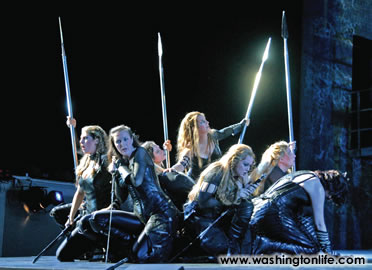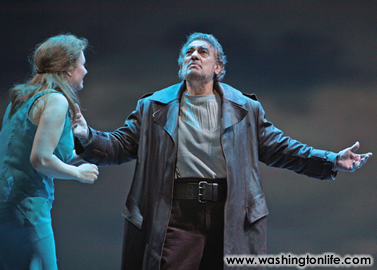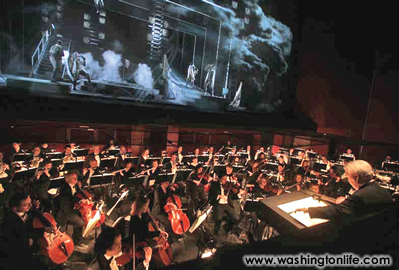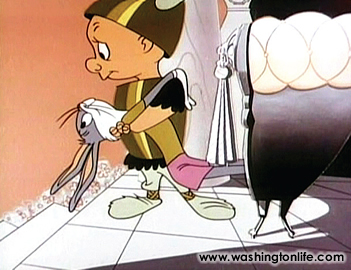|
Domingo Puts on Wagner's Ring But is it sized too big for the WNO? BY ROLAND FLAMINI In the opera world, producing Richard Wagner's Ring cycle is one of those monumental projects that separate the men from the boys. Of course, if the result is a flop, it's back to being boys, but that's not likely to happen to the Washington National Opera, now halfway through a highly successful staging of what is arguably the biggest work in Western music. Wagner subtitled the 15-hour-long epic Der Ring des Nibelungen, "a stage festival for three days and a preliminary evening." It took him 28 years to write, re-write, and rehearse before its first performance in 1876. In its 2006 season the WNO staged, to critical acclaim, the preliminary evening Das Rheinegold. In the current season came the second opera in the cycle, Die Walkure. The opera will now skip a year to get its breath back and raise some more cash before presenting Siegfried in 2009 and Gotterdamerung in 2010.
You would have thought the Ring cycle was so deeply embedded in its source material of German and Scandinavian myths and folk tales as to make its organic unity inviolable, allowing little leeway in its interpretation. But, as Anthony Tommasini, the opera critic of the New York Times observed, when thinking of producing Wagner's masterwork "You'd better have a novel concept .... We've had industrial Rings, an environmentally green Ring, and several cosmic Rings with mystical lighting and abstract scenery." For the WNO, director Francesca Zambello has come up with what she calls an "American Ring." Or did she mean an anti-American Ring? Given that she transposes Wagner's themes of greed, corruption and the abuse of power to an American (actually a Washingtonian) context, she in effect has produced an operatic indictment of the American system. Throughout Wagner's great saga, mythic figures struggle for possession of a magic ring that bestows the power to rule the world. Even the knowledge that the ring ultimately destroys whoever owns it fails to discourage their quest. If by now you're thinking H.R. Tolkien, you're more or less on the right track. In the WNO's American Ring the German deities become contemporary, or near contemporary, American gods - in other words capitalists, politicians, and celebrities, i.e. the rich and famous. The Rhine River becomes the Colorado River, but perhaps should be the Potomac given Zambello's explanation that "the great themes of the ring, nature, power and corruption, resound through America's past." She adds, "In many respects, the politicians and celebrities that are today's superstars perform as if they were the gods of Valhalla. It is especially fitting to undertake an American Ring in Washington D.C., where the concept of global power is a feature of daily life." Zambello's Wotan, the chief god, is a power hungry suit - an uber-capitalist alternating between self-justification and hand wringing self-guilt. The evil gnome Alberich (who has the ring in the first place) presides over a dark, sulfurous mine worked by mostly African children - not just evoking the history of slavery in America, but a reminder that child labor remains a hideous abuse in several parts of the world. In a twitch of political correctness, Erda the earth-goddess shows up in Native American dress looking, as one critic put it "like the woman in the Land O'Lakes label." In Die Walkure, the famous "Ride of the Valkyries" (Wotan's war rior maiden daughters) becomes the "Drop of the Valkyries." They don't arrive on horseback, they surge in by parachute against a backdrop of modern warfare, which some saw as a commentary on the current U.S. military engagement. The funny thing is that the WNO's "American Ring" is likely to have wide appeal on the European opera circuit because with little effort it can easily be fitted into Europe's instinctive anti-American reflex. "Eppur' si muove," as Galileo muttered after he had been condemned for heresy for saying the earth was round and orbited the sun - "and yet it moves." Washingtonians have filled the opera house for Das Rheingold and Die Walkure, not because of a taste for self flagellation, but because the singing in both has been simply spectacular. Of Walkure, Tim Page, the Washington Post's distinguished music critic wrote (one might almost say gushed, but he was right): "I don't know whether the Washington National Opera has ever presented a more thrilling 70 minutes than Act I, which featured the company's 66-year-old general director, Placido Domingo, as Siegmund and the wonderful German soprano Anja Kampe as Sieglinde in rapturous duet. Their voices - fresh, lithe and lustrous - easily filled the hall, but they never sounded strained and there was none of that amped-up shouting that so commonly passes for Wagnerian declamation. A glorious teaming: Exactly what an operatic love duet should be." The Times' Tommasini called the WNO's earlier Das Rheingold production "Fresh and impressive" and "colorful, abstract and well cast," even if he wasn't sold on the "American spin," suggesting that in future productions it ought to be "damped down." Der Ring des Nibelungen is an awesome rite of passage for any opera company, and the WNO has made a smashing success of it. The Washington production (shared with the San Francisco Opera) may justify the English 18th century literary gadfly Samuel Johnson's definition of opera as "an exotic and irrational entertainment," but isn't it the singing that counts? Here, the casts in both instances have shone almost to a man or woman, and none more than Domingo himself, the "Energizer Bunny" of the opera world, who runs both the Washington National and the Los Angeles Operas, sings at the Met, fills in his spare time with opera engagements all over the globe - and gives the WNO governing board collective heart failure with the cost of each production, which runs between $1.5 and 2.5 million. From all accounts it's usually Domingo who pushes the envelope to bring new, or rarely heard operatic works into the season's program, when the more bottom line oriented board would prefer to sail closer to the wind with crowd pleasing Traviatas and Rigolettos. But if the result is Wagner's Ring or the WNO's stellar production of Janacek's Jenufa, this creative conflict is doing its job. The Domingo factor is what currently gives the Washington National Opera its distinctive edge. One should go and listen to him singing more or less anything because, as Tim Page says, "as hard as it may be to believe right now, Domingo won't be singing forever."
| ||||||||||||||||




